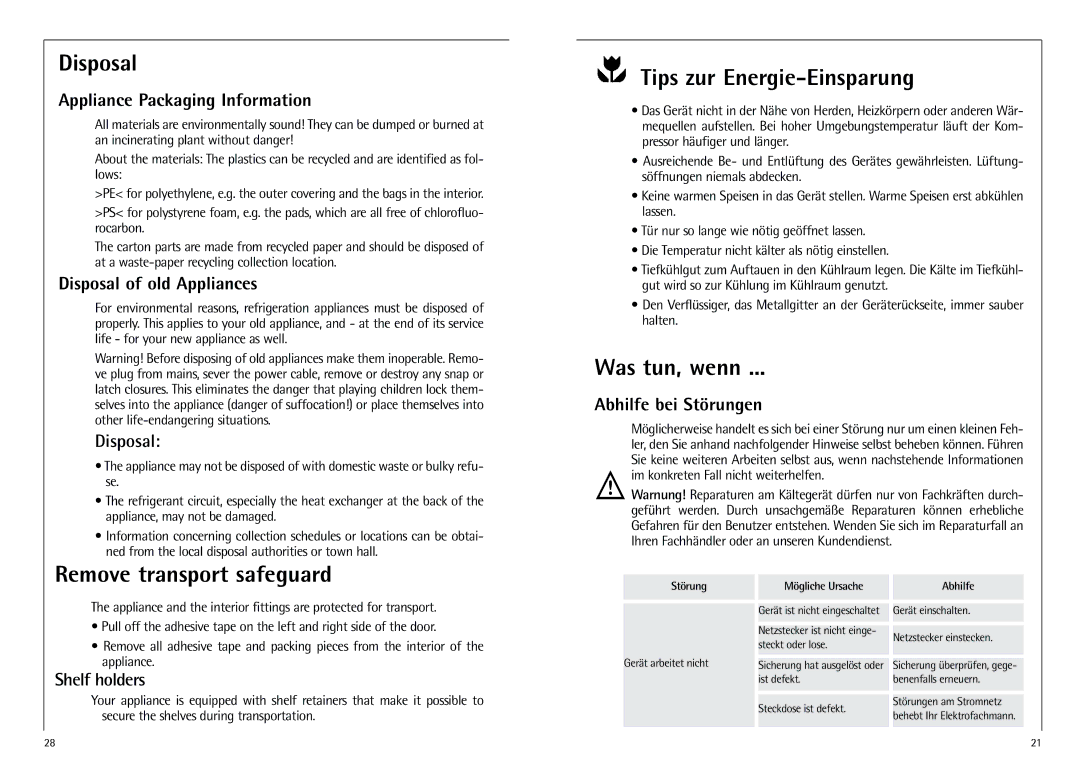
Disposal
Appliance Packaging Information
All materials are environmentally sound! They can be dumped or burned at an incinerating plant without danger!
About the materials: The plastics can be recycled and are identified as fol- lows:
>PE< for polyethylene, e.g. the outer covering and the bags in the interior.
>PS< for polystyrene foam, e.g. the pads, which are all free of chlorofluo- rocarbon.
The carton parts are made from recycled paper and should be disposed of at a
Disposal of old Appliances
For environmental reasons, refrigeration appliances must be disposed of properly. This applies to your old appliance, and - at the end of its service life - for your new appliance as well.
Warning! Before disposing of old appliances make them inoperable. Remo- ve plug from mains, sever the power cable, remove or destroy any snap or latch closures. This eliminates the danger that playing children lock them- selves into the appliance (danger of suffocation!) or place themselves into other
Disposal:
•The appliance may not be disposed of with domestic waste or bulky refu- se.
•The refrigerant circuit, especially the heat exchanger at the back of the appliance, may not be damaged.
•Information concerning collection schedules or locations can be obtai- ned from the local disposal authorities or town hall.
Remove transport safeguard
The appliance and the interior fittings are protected for transport.
•Pull off the adhesive tape on the left and right side of the door.
•Remove all adhesive tape and packing pieces from the interior of the appliance.
Shelf holders
Your appliance is equipped with shelf retainers that make it possible to secure the shelves during transportation.
Tips zur Energie-Einsparung
•Das Gerät nicht in der Nähe von Herden, Heizkörpern oder anderen Wär- mequellen aufstellen. Bei hoher Umgebungstemperatur läuft der Kom- pressor häufiger und länger.
•Ausreichende Be- und Entlüftung des Gerätes gewährleisten. Lüftung- söffnungen niemals abdecken.
•Keine warmen Speisen in das Gerät stellen. Warme Speisen erst abkühlen lassen.
•Tür nur so lange wie nötig geöffnet lassen.
•Die Temperatur nicht kälter als nötig einstellen.
•Tiefkühlgut zum Auftauen in den Kühlraum legen. Die Kälte im Tiefkühl- gut wird so zur Kühlung im Kühlraum genutzt.
•Den Verflüssiger, das Metallgitter an der Geräterückseite, immer sauber halten.
Was tun, wenn ...
Abhilfe bei Störungen
Möglicherweise handelt es sich bei einer Störung nur um einen kleinen Feh- ler, den Sie anhand nachfolgender Hinweise selbst beheben können. Führen Sie keine weiteren Arbeiten selbst aus, wenn nachstehende Informationen im konkreten Fall nicht weiterhelfen.
Warnung! Reparaturen am Kältegerät dürfen nur von Fachkräften durch- geführt werden. Durch unsachgemäße Reparaturen können erhebliche Gefahren für den Benutzer entstehen. Wenden Sie sich im Reparaturfall an Ihren Fachhändler oder an unseren Kundendienst.
Störung |
| Mögliche Ursache |
| Abhilfe |
|
|
|
|
|
|
|
|
|
|
|
| Gerät ist nicht eingeschaltet |
| Gerät einschalten. |
|
|
|
|
|
|
|
|
|
|
|
| Netzstecker ist nicht einge- |
| Netzstecker einstecken. |
|
| steckt oder lose. |
| |
|
|
|
| |
Gerät arbeitet nicht |
|
|
|
|
| Sicherung hat ausgelöst oder |
| Sicherung überprüfen, gege- | |
|
| ist defekt. |
| benenfalls erneuern. |
|
|
|
|
|
|
|
|
|
|
|
| Steckdose ist defekt. |
| Störungen am Stromnetz |
|
|
| behebt Ihr Elektrofachmann. | |
|
|
|
| |
|
|
|
|
|
28 | 21 |
